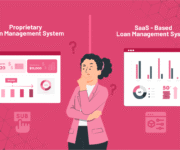Salesforce changed the course of the enterprise-grade loan recovery software industry when the company rolled out a software-as-a-solution (SaaS) CRM in 1999. Over the next few decades, cloud-based SaaS solutions garnered immense popularity, replacing on-premise solutions across various sectors.
A Gartner study projected that global SaaS spending will likely reach $195 million by the end of 2023 – a whopping 50% rise from 2018. The report also suggests that overall global spending on on-premise solutions is expected to decrease by 7% by 2024.
These figures indicate a strong inclination toward SaaS and the diminishing demand for on-premise software. However, the question is – is this trend sustainable in the long run?
This article sheds light on the pros and cons of both types of loan recovery software: on-premise and SaaS, to demystify the future of loan recovery in the upcoming years.
Before we dig deeper, let’s get a grip on the major features of on-premise and SaaS.
What is an On-premise Loan Recovery Software?
If a bank or a financial firm uses an on-premise loan recovery solution, it suggests that the loan recovery infrastructure and all applications are hosted within its technical ecosystem. The onus of the maintenance of hardware and other components rests solely on the organisation.
Traditionally, banks and financial companies heavily relied on on-premise solutions. However, the increasing demand for more business deliverables, accuracy, the need for data-driven decision-making, and the advent of subscription-based pricing models have changed the status quo.
What is a SaaS-based Loan Recovery Software?
Unlike their on-premise counterparts, SaaS loan recovery software is hosted on the cloud, eliminating the need to install hardware infrastructure in a traditional banking software suite.
These solutions enable banks or lenders to minimise their hardware footprint, reducing hosting charges and overheads.
As a result, although on-premise solutions provide several benefits, financial institutions are favouring aaS products owing to their AI-powered capabilities, convenience and flexibility.
Pros of On-premise Loan Recovery Software
While the demand for SaaS loan recovery software is rising, it does not mean that on-premise solutions are completely obsolete. Here are a few reasons why:
-
Control over Customisation and Updates
One of the major reasons why banks and credit unions often gravitate toward on-premise loan recovery solutions is the unparalleled control over customisations, implementations and updates. Banks can also customise the software based on their unique requirements.
-
Compliance and Regulations
The financial services sector is no stranger to stringent regulations and compliance requirements. Therefore, many institutions prefer complete control over compliance to increase their brand reputation and avoid hefty penalties.
-
Data Security
When organisations opt for on-premise software, their data is stored and managed within the internal network, offering reinforced data security. Clients have complete control over critical business data, offering a secure environment.
-
Offline Access
Since on-premise loan recovery software is hosted internally within an organisation’s facility, it can be easily accessed without an internet connection. This is worthwhile across regions with unstable and unreliable internet access, ensuring seamless loan recovery.
Cons of On-premise Loan Recovery Software
After evaluating the benefits of on-premise loan recovery software, let’s explore some glaring drawbacks:
-
High Upfront and Total Cost
Apart from the operating costs, on-premise loan recovery solution comes with significant upfront costs, including purchasing new hardware and implementation costs. Furthermore, lenders would also need to hire a dedicated IT team.
-
Time-consuming Implementation Process
The on-premise implementation process can be complex as it needs to integrate with the lender’s existing tech infrastructure. This increases the time to deploy the solution and often requires more resources.
-
Additional Costs for System Upgrade and Maintenance
On-premise solutions require consistent software upgrades. However, these upgrades are not free and come with additional fees.
On the Rise: Benefits of SaaS Loan Recovery Software
Now, let’s explore the advantages of using SaaS-based loan recovery software:
-
Low Operating Cost
One of the most notable advantages of using a SaaS-based loan recovery solution is the low upfront and sustainable costs over time. Additionally, software vendors ensure the solution runs smoothly.
-
Better Scalability
Scalability is another major factor that fuels the demand for SaaS-based loan recovery software among banks and other entities in the financial services sector. A SaaS solution is well-equipped to aid the sustainable growth of financial institutions based on their requirements.
-
No Need for Additional Staff
SaaS-based loan recovery solutions are typically hosted on the cloud. The benefit is that you do not need additional IT personnel, enabling your current IT team to focus on their core business functions.
Some Drawbacks of SaaS-based Loan Recovery Software
Now, let us examine areas where SaaS-based loan recovery software has some limitations:
-
Limited Room for Customisations
It is worth noting that lenders or credit unions do not own SaaS-based loan recovery solution. This means they need to purchase a developer license from the software vendor to customise the solution based on their needs.
Further, it is also vital to evaluate whether the SaaS solution is backwards compatible. Backward compatibility ensures that customisations do not interfere or break when applying automatic upgrades.
-
High Long-term Costs
Although SaaS solutions come with low, upfront costs and are economical in the short term, they may not provide similar cost benefits in the long run. The higher costs can be primarily attributed to a host of factors, including incremental growth of subscription fees, scalability costs, additional bandwidth charges, and customisation costs, to name a few.
-
Connectivity
Unlike on-premise solutions, SaaS loan recovery software is hosted on the cloud and does not work offline. This becomes a significant hurdle for lenders operating in areas with unreliable internet connectivity.
Bottom Line: SaaS vs On-Premise Loan Recovery Software
Both types of loan recovery software offer their fair share of pros and cons. Consider plenty of factors, including risk, recurring fees, unhidden fees, and more. Therefore, it is recommended that you conduct research and choose a suitable option solely based on your needs.
As a SaaS-based platform, Finezza provides end-to-end loan management solutions that facilitate agile and flexible loan recovery and management. Primarily built to tackle the challenges lenders face, the lending software solution is loaded with multiple features, such as flexible payment modules, loan document generation, NPA management, and more.
Book a demo and learn how our loan management system can help you.




Leave a Reply